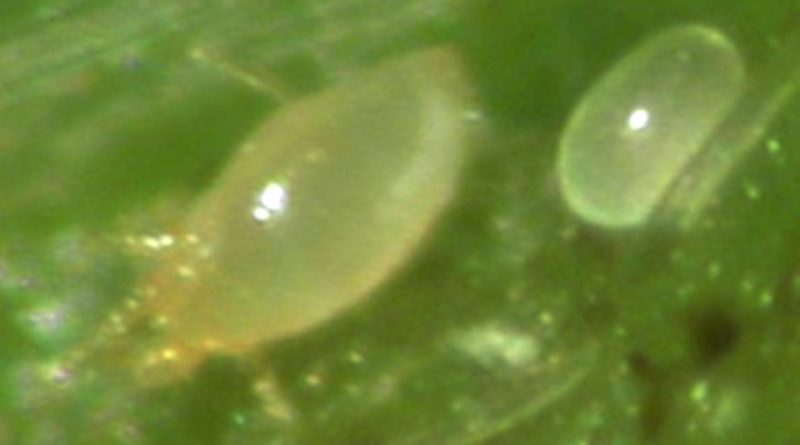Steneotarsonemus pallidus
Steneotarsonemus pallidus
The cyclamen mite (Steneotarsonemus pallidus (Banks)) is a tiny mite belonging to the Tarsonemidae family.
Systematics –
From a systematic point of view, it belongs to the Eukaryota Domain, Animalia Kingdom, Subgenus Eumetazoa, Phylum Arthropoda, Class Arachnida, Order Acari, Family Tarsonemidae and therefore to the genus Steneotarsonemus and to the species S. pallidus.
The terms are synonymous: Tarsonemus pallidus Banks, 1901, Tarsonemus fragariae Zimmerman, 1905, Steneotarsonemus pallidus (banks), beer, 1954, Phytodromus pallidus (Banks), Lindquist, 1987.
Geographical Distribution and Habitat –
The cyclamen mite was first noticed in New York in 1898 and in Canada in 1908. It was described by Banks (1901) as Tarsonemus pallidus in Jamaica. Today this small Tarsonemidae is generally distributed in many countries. It is widely distributed in North America, Hawaii, Europe and Asia.
It is often found as a parasite on Cyclamens (Cyclamen spp.) And African violets (Saint Paulia ionantha). It requires a warm and humid environment and therefore can create particular problems in greenhouses and in protected installations.
Morphology –
Steneotarsonemus pallidus is a very small mite invisible to the naked eye.
The male measures 0.22 mm x 0.115 mm and is yellow. In adult males the fourth pair of legs is modified and used to carry pupae or adult females.
The female measures 0.3 x 0.15 mm and is light brown in color with a leathery cuticula.
The male has approximately 75% of the size of the female.
The eggs are relatively large (125 μ X 75 μ), elliptical, opaque, smooth and almost double the width. The larvae are opaque white with a particular triangular enlargement at the rear end of the body. Pupae are not mobile.
The buccal apparatus consists of robust palps and indistinct segmented palps inserted on the apical portion of the capitulum. Lean, stylish and paired chelicerae are also part of the mouth parts and are inserted into plant cells during feeding.
Cyclamen mite can be confused with Polyphagotarsonemus latus (Banks), but this is wider, smaller and moves much faster.
Attitude and biological cycle –
The cyclamen mite can have up to seven 7 generations after the first one. The first develops in a month; during the summer the succession of generations is faster (about 10 days). S. Pallidus prefers high humidity (80 – 90%) and a temperature below 20 ° C to reproduce and grow. This mite escapes from the light, so much so that individuals gather where the vegetation is denser and within the plant.
The eggs are laid 1 to 3 per day in groups, with a total of 12-16 eggs at a time. The duration of the spawning phase varies from three to seven days, from one to four days for the larvae, from two to seven days for resting pupae or from one to three weeks per generation.
The species usually winters in the form of fertilized females sheltered in the leaves folded in the anfractuosity of the shoots or petioles. The population can sometimes suffer a significant reduction following a severe winter mortality.
Ecological Role –
Steneotarsonemus pallidus is a parasite of many ornamental flowers and shrubs such as cyclamen, African violet, begonia, gerbera, ivy, chrysanthemums, geraniums, fuchsia, larkspur, petunia, snapdragon and other plants grown in greenhouses. If the humidity is high, even the strawberries grown in the field can be infested.
In the event of a moderate attack, the top layer of the leaf appears crumpled and undulating, presenting even small pustules. The plant is in fact affected in the petioles which cannot therefore grow. A more massive attack causes the “Dwarfism” of the heart of the plant. The young leaves cannot open completely: their flap and buds remain small. They turn yellow become brittle, so they run out and die.
In infested strawberry plants there is a rough and rough upper leaf surface, irregular bending and leaf margins and central vessels that swell upwards as blisters.
Care must be taken to avoid introducing this pest into greenhouses on plants, hands or clothes.
Since cyclamen mites are parthenogenetic, a single female can quickly produce a colony of mites large enough to cause damage and spread to surrounding plants.
To identify these mites, look for deformed, distorted, shredded, uneven leaves, thickening or shortening of the petioles.
To eradicate this mite, remember that both the eggs, the larvae, the pupae and the adult stages are often well protected by chemical control because they are protected in the leaf and / or flower buds. Mites on seedlings can be completely killed by immersion in water at 43.5 ° C for 30 minutes.
Guido Bissanti
Sources
– Wikipedia, the free encyclopedia.
– Laffi f., 1983. Mites of agricultural interest. University Publishing Librarian Cooperative. Bologna.

